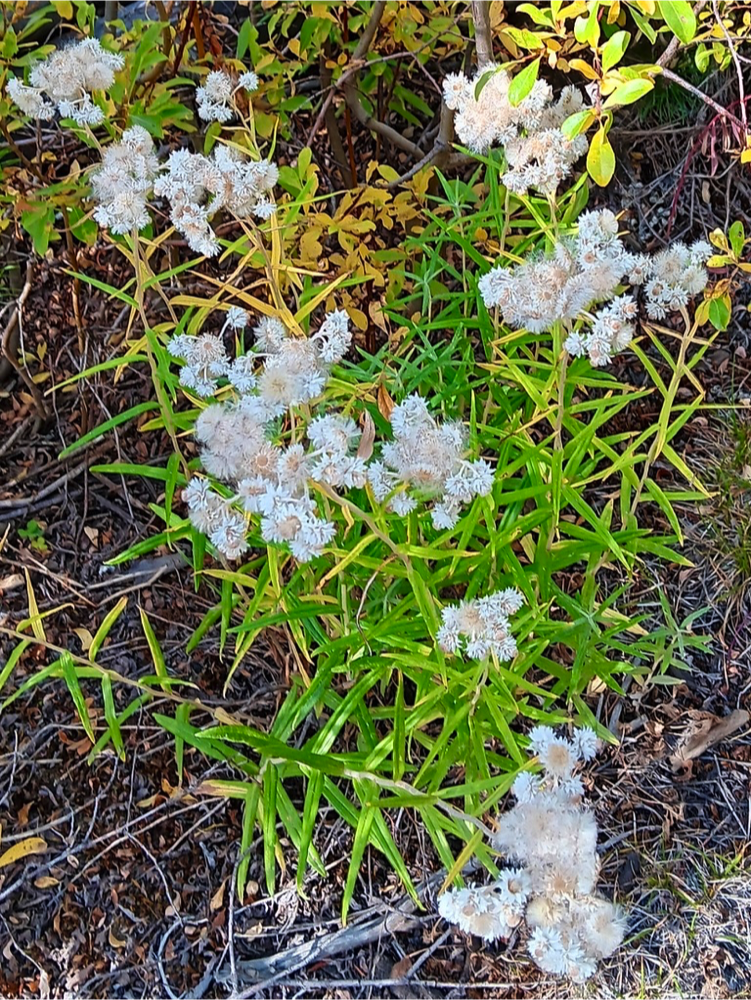
by Marilee Henry

Our plant in the spotlight this month is a favorite in pollinator gardens for its beauty and for its value as another late-season source of nectar and pollen for bees, butterflies, beetles, and other pollinators, blooming well into September and even early October. Pearly everlasting is probably familiar to most as it is found throughout our state and across much of Canada and the US except in the SE region. It tolerates a wide range of habitats from sea level to subalpine elevations. It can be seen growing along roadsides, in moist meadows, in dry rocky areas, open slopes, old burns (as pictured above at Table Mountain, east of Blewett Pass), and partially shaded hillsides.
Pearly everlasting can be recognized by its inflorescences of numerous small flowers with golden disks surrounded by prominent whorls of pearly-white papery bracts on erect silvery-green vegetation. Growing to about 3 feet maximum height, the plant's stems and lance-shaped leaf undersides are woolly with dense soft hairs (trichomes) that reduce water-loss as well as discourage predation by sap-sucking insects, making the plant quite drought-tolerant.
Though the genus Anaphalis has a number of species native to India and SE Asia, pearly everlasting is its only species native to North America, hosting 6 kinds of moth/butterfly larvae that are a critical high-energy food source for birds raising their chicks. One of these butterfly species that depend on pearly everlasting is the beautiful American Painted Lady (Vanessa virginiensis) shown in these images and featured in this video from the Native Plant Channel, where you can see the lovely "pearly" effect of a large bed of the plant as well as a larval stage of the butterfly hiding amongst its leaves.
Besides being a favorite for pollinator beds and rock gardens, the blooms with their papery pearly-white bracts are known for use in dried flower arrangements. Indigenous peoples used this plant in many ways, including in poultices for burns, in teas and steam for aching joints and colds, and as a substitute for tobacco. Yellow, green, and brown dyes were made from different parts of the plant. The young leaves and shoots are edible when cooked.
This hardy perennial, though tolerating varied moisture regimes and soil types, will do best in sandy well-draining soils in full sun. An unusual characteristic of pearly everlasting (besides having no ray flowers) is that this species is subdioecious, meaning that a plant will have either male or female flowers but usually not both, the differences in the genders being shown here. It is therefore important to have plants of each if you wish to produce seeds. However, this species will spread by rhizomes, so even if you start with a single plant, it will in time grow into a cluster. Propagation is easily accomplished by rhizome cuttings or seeds collected in late fall.
Start a pearly everlasting bed for butterflies this month!
Remember, "You are nature's best hope!" - Doug Tallamy, author of "Nature's Best Hope" and "Bringing Nature Home".
Marilee Henry
Kirkland Community Wildlife Habitat Team Member, Washington Native Plant Society (WNPS) Native Plant Steward, Green Kirkland Steward, Finn Hill Neighborhood Alliance Contributor
Oxbow Farm and Conservation Center
Carnation. October 5, 2024, 10am to 4pm.
October 2024 SER-UW Native Plant Sale
Seattle. Online (October 7 - 11) and in person (October 20).